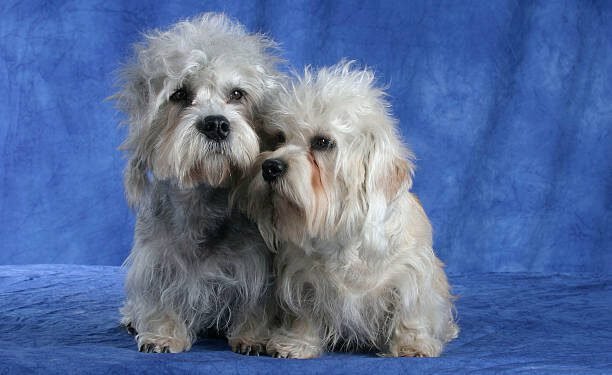Introduction:
Did you know that the Dandie Dinmont Terrier, with its distinctive appearance and endearing personality, is more than just a pet? In this article, we’ll delve into what sets the Dandie Dinmont Terrier apart, exploring the breed’s unique characteristics and why choosing the right dog for your lifestyle is crucial.
The Dandie Dinmont Terrier is a breed that stands out for its exceptional traits, both in terms of appearance and temperament. Understanding these characteristics is essential for prospective pet owners, as it directly influences the dog’s behavior, exercise needs, and overall well-being.
Table of Contents
Dandie Dinmont Terrier at a Glance:
Let’s break down the essential details about the Dandie Dinmont Terrier in a comprehensive table:
| Field | Information |
|---|---|
| Height | 8 to 11 inches |
| Weight | 18 to 24 pounds |
| Life span | 12 – 15 years |
| Good with | great family dogs |
| Temperament | affectionate, calm, and companionable |
| Intelligence | moderate |
| Shedding amount | low-shedding |
| Grooming | Regular grooming is essential |
| Exercise needs | low exercise needs |
| Energy level | moderate energy level. |
| Barking level | low to moderate. |
| Drool amount | low droolers. |
| Coat length/texture | double coat, pepper, mustard |
| Colors | dark bluish-black to light silvery gray. |
| Patterns | Pepper, Musterd |
While specific details might be elusive, the intrigue surrounding the Dandie Dinmont Terrier breed only adds to its allure. Now, let’s explore what makes these dogs stand out among the vast array of breeds.
Breed History and Origin:

Exploring Their Roots:
The Dandie Dinmont Terrier has a rich history that traces back to the Scottish borders. Developed in the 17th century, this breed’s roots involve the crossing of various terriers, including the Skye Terrier and the now-extinct Scotch Terrier. Named after a character in Sir Walter Scott’s novel, “Guy Mannering,” the Dandie Dinmont Terrier gained recognition for its distinct appearance and versatile skills.
Notable Traits:
One of the standout traits in the Dandie Dinmont Terrier’s history is its versatility. Originally bred for hunting, these terriers were prized for their ability to control vermin on farms. Their distinctive appearance, with a long body, unique topknot, and large, expressive eyes, added to their appeal both in the field and as companion animals.
Relevance of Origin:
Understanding the origin of the Dandie Dinmont Terrier is crucial in comprehending its present characteristics. The intentional breeding for specific traits has resulted in a dog that is not only charming but also intelligent and adaptable. Today, the Dandie Dinmont Terrier remains a beloved breed known for its distinctive appearance and amiable nature.
Dandie Dinmont Terrier at a Glance:
Let’s break down the essential details about the Dandie Dinmont Terrier in a comprehensive table:
While specific details might be elusive, the intrigue surrounding the Dandie Dinmont Terrier breed only adds to its allure. Now, let’s explore what makes these dogs stand out among the vast array of breeds
Understanding the Dandie Dinmont Terrier Breed’s Traits:

Physical Characteristics:
The Dandie Dinmont Terrier boasts a unique set of physical attributes inherited from its terrier lineage.
- Size: While specific height and weight details are not known, Dandie Dinmont Terriers are generally small to medium-sized dogs.
- Coat Type: They have a distinctive double coat with a soft, dense undercoat and a harder, wiry topcoat. Regular grooming is necessary to maintain their coat.
- Color: The breed comes in various colors, including mustard and pepper. The mustard color is a rich, reddish-brown, while pepper includes various shades of blue-black.
Temperament Overview:

Dandie Dinmont Terriers are known for their unique temperament, making them delightful companions.
- Suitability as Family Pets: They make excellent family pets, thanks to their affectionate nature and loyalty.
- Interaction with Other Pets: Dandie Dinmont Terriers can get along well with other pets, especially when introduced and socialized early.
- Safe with Children: They tend to be safe and playful with children, adding joy to family life.
Environment Needs:
To ensure Dandie Dinmont Terriers thrive in your home environment, consider the following factors:
- Space: While they can adapt to living in apartments, they appreciate having enough space to move around. Regular walks and playtime are essential.
- Temperature Sensitivity: Their double coat provides some insulation, but they may prefer moderate temperatures. Ensure they have a comfortable living environment.
Common Behavioral Traits:
Understanding the typical behaviors of Dandie Dinmont Terriers is key to fostering a positive relationship.
- Playfulness: These terriers are known for their playful nature and enjoy engaging in various activities.
- Alertness: Inherited from their hunting background, Dandie Dinmont Terriers can be alert and responsive to their surroundings.
- Loyalty: They form strong bonds with their owners and are known for their loyalty.
Addressing Behavioral Issues:
While Dandie Dinmont Terriers are generally well-mannered, addressing specific behavioral issues is important:
- Training: Consistent and positive reinforcement training is effective for Dandie Dinmont Terriers. Early socialization is crucial for well-rounded behavior.
- Energy Outlet: Providing outlets for their energy, such as daily walks and play sessions, helps prevent boredom-related behaviors.
Popularity and Recognition:
Current Popularity: The Dandie Dinmont Terrier, while not among the most popular breeds, has a dedicated fan base. Their unique appearance and charming personality attract those seeking a distinctive canine companion. Trends in ownership may vary regionally, but their allure remains timeless.
Breed Recognition:
The breed has garnered recognition from prominent kennel clubs and breed organizations. Organizations like the American Kennel Club (AKC) and The Kennel Club in the UK recognize and categorize the Dandie Dinmont Terrier, contributing to its status as a distinct and recognized breed.
Notable Breed Varieties:
The Dandie Dinmont Terrier is a breed with a singular variety, but there can be distinctions within the breed based on geographic locations or breeding practices. However, these distinctions are often subtle, with the breed standard maintaining a cohesive set of characteristics.
In the next section, we’ll delve into the health considerations for Dandie Dinmont Terriers, ensuring you have a comprehensive understanding of their well-being.
While specific details might be elusive, the intrigue surrounding the Dandie Dinmont Terrier breed only adds to its allure. Now, let’s explore what makes these dogs stand out among the vast array of breeds.
Health Considerations and Care:
Common Health Issues:
Like any breed, Dandie Dinmont Terriers are prone to certain health issues. Being aware of these can help in early detection and preventive care. Common health issues in Dandie Dinmont Terriers include:
- Intervertebral Disc Disease (IVDD): This is a spinal condition that can affect Dandie Dinmont Terriers, leading to pain and potential paralysis. Regular check-ups and monitoring can help manage this condition.
- Cataracts: Dandie Dinmont Terriers may be prone to developing cataracts, affecting their vision. Regular eye examinations are crucial for early detection and appropriate intervention.
- Thyroid Issues: Some Dandie Dinmont Terriers may experience thyroid problems, which can impact their overall well-being. Regular thyroid function tests are recommended.
- Hip Dysplasia: While not as common as in larger breeds, hip dysplasia can still occur. Maintaining a healthy weight and regular exercise can help reduce the risk.
- Ear Infections: Due to their unique ear shape and dense coat, Dandie Dinmont Terriers may be prone to ear infections. Regular cleaning and inspection of the ears can help prevent issues.
Lifespan and Longevity:
On average, Dandie Dinmont Terriers have a lifespan of 12 to 15 years. Several factors can influence their longevity, and responsible pet ownership plays a crucial role. Here are tips for promoting a longer and healthier life for your Dandie Dinmont Terrier:
- Regular Veterinary Check-ups: Schedule routine check-ups with the veterinarian to monitor your dog’s overall health and address any emerging issues.
- Balanced Nutrition: Provide a well-balanced and nutritious diet tailored to the specific needs of Dandie Dinmont Terriers. Consult with your veterinarian to determine the best dietary plan.
- Regular Exercise: Despite their small size, Dandie Dinmont Terriers are an active breed that benefits from regular exercise. Daily walks andplay sessions contribute to their physical and mental well-being.
- Dental Care: Dental health is crucial for the overall well-being of your Dandie Dinmont Terrier. Implement a dental care routine, including regular brushing and dental check-ups.
- Weight Management: Maintain a healthy weight for your dog to prevent obesity-related issues. Consult with your veterinarian to determine the ideal weight and feeding portions.
- Preventive Medications: Stay updated on preventive medications, including vaccinations, flea control, and heartworm prevention, to safeguard your dog against common health threats.
- Regular Grooming: Due to their unique coat, Dandie Dinmont Terriers require regular grooming. Brush their coat to prevent matting, and trim their nails to ensure comfort and mobility.
By incorporating these practices into your care routine, you can contribute to the overall well-being and longevity of your Dandie Dinmont Terrier.
Exercise and Activity Recommendations:
Ensuring that Dandie Dinmont Terriers receive adequate exercise is crucial for their overall well-being. Tailoring their exercise routine to their energy levels and natural instincts is key. Here’s a detailed plan to keep your Dandie Dinmont Terrier active and healthy:
Types of Exercise:

- Playtime:
- Engage in interactive play with toys that stimulate their mental and physical abilities.
- Use puzzle toys to keep their minds active and provide a challenge.
- Walks:
- Take daily walks to meet their exercise needs and allow them to explore their surroundings.
- Use a harness to ensure proper control during walks.
- Agility Training: Set up a mini-agility course in your backyard to enhance your agility and coordination. Use tunnels, hurdles, and weave poles for a fun and challenging experience.
- Socialization Activities:
- Arrange playdates with other dogs to encourage socialization.
- Visit dog parks where they can interact with different breeds and personalities.
- Swimming (if applicable):
- If your Dandie Dinmont Terrier enjoys water, consider introducing them to swimming.
- Ensure a safe and controlled environment, especially if they are new to water activities.
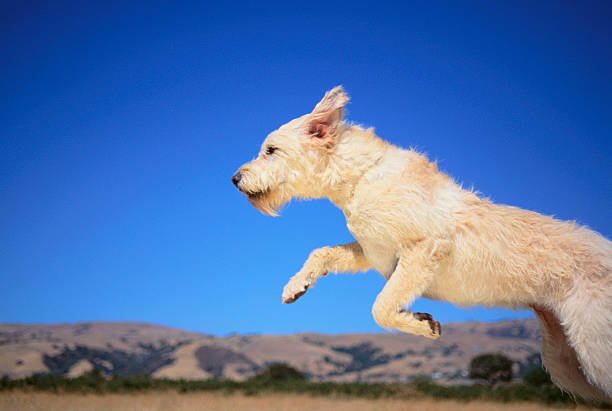
Duration and Frequency:
- Playtime:
- 20-30 minutes of interactive play sessions daily.
- Walks:
- 30-45 minutes of brisk walking, at least twice a day.
- Agility Training: 15-20 minutes of agility exercises, 2-3 times a week.
- Socialization Activities:
- Weekly playdates and visits to dog parks for social interaction.
- Swimming (if applicable):
- 15-20 minutes of supervised swimming sessions, 1-2 times a week.
Remember to adapt the exercise routine based on your Dandie Dinmont Terrier’s age, health, and individual preferences. Regular exercise not only keeps them physically fit but also contributes to their mental stimulation and overall happiness.
Nutrition and Feeding Guidelines:
Dietary Recommendations:
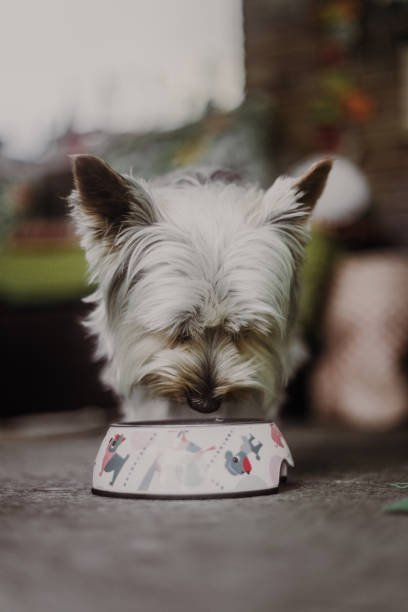
Providing the right nutrition is crucial for the well-being of Dandie Dinmont Terriers. Here are dietary recommendations based on their size, age, and activity level:
Puppy Nutrition:
- High-Quality Puppy Food: Choose a premium puppy food designed for small to medium-sized breeds.
- Frequent, Small Meals: Feed puppies three to four times a day to support their rapid growth and energy needs.
- Protein and Calcium: Ensure the food has adequate protein and controlled calcium levels for proper bone development.
Adult Nutrition:
- Balanced Diet: Provide a well-balanced diet that includes protein, fats, carbohydrates, vitamins, and minerals.
- Portion Control: Divide the daily food into two meals to prevent overeating and aid digestion.
- Weight Management: Monitor their weight and adjust portions to maintain a healthy weight.
Senior Nutrition:
- Joint Health Supplements: Consider senior dog food with added glucosamine and chondroitin for joint health.
- Lower-Calorie Content: Adjust the calorie intake to accommodate their lower activity levels.
- Regular Vet Check-ups: Schedule regular vet check-ups to address any age-related dietary needs.
Dietary Restrictions and Allergies:
Dandie Dinmont Terriers may have specific dietary restrictions or allergies, although these can vary among individuals. Common allergies include grains, poultry, or certain additives. Consult with a vet to identify and address any dietary sensitivities.
Feeding Schedule:
Establishing a consistent feeding schedule contributes to the well-being of Dandie Dinmont Terriers. Here’s a general guide:
- Puppy Feeding Schedule: Feed puppies three to four times a day, gradually transitioning to two meals a day by six months of age.
- Adult Feeding Schedule: Provide two meals a day for adult Dandie Dinmont Terriers.
- Senior Feeding Schedule: Stick to a regular schedule for senior dogs, adjusting portion sizes based on their activity level and health status.
Personal Stories and Testimonials:

Real-Life Experiences with Dandie Dinmont Terriers:
1. The Unbreakable Bond:
One Dandie Dinmont Terrier owner, Sarah, shares her heartwarming story of the unbreakable bond she formed with her furry companion, Max. Despite Max being a small dog, his loyalty and affection have created an indelible mark on Sarah’s life.
Testimonial:
“Max came into my life when I needed a friend the most. His small size belies the enormous love and joy he brings. We’ve tackled life’s challenges together, and his loyalty is truly unmatched. The Dandie Dinmont Terrier’s reputation for loyalty is no exaggeration!”
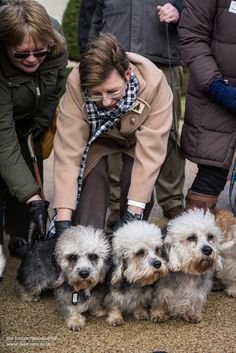
2. A Comedic Companion:
Testimonial:
“Daisy is not just a pet; she’s a daily dose of laughter. From her playful zoomies around the house to her funny expressions, life with a Dandie Dinmont Terrier is a perpetual comedy show. It’s impossible to stay gloomy with Daisy around!”
John, a proud owner of a Dandie Dinmont Terrier named Daisy, highlights the breed’s playful and comedic nature. Daisy’s antics and unique personality have turned everyday moments into laughter-filled memories.
Cost of Owning a Dandie Dinmont Terrier:
Owning a Dandie Dinmont Terrier comes with various expenses, both upfront and ongoing. Understanding the financial commitment is crucial for providing your furry friend with the best care possible.
Upfront Costs:
- Purchase or Adoption Fee: Prices for Dandie Dinmont Terrier puppies can vary based on factors like pedigree, breeder reputation, and geographic location. On average, expect to pay between $800 and $2,000.
- Initial Veterinary Expenses: This includes vaccinations, spaying or neutering, and a general health checkup. Initial vet expenses can range from $150 to $300.
- Essential Supplies: Purchasing necessary items like a bed, collar, leash, food and water bowls, toys, and grooming tools. Budget around $200 to $300 for these initial supplies.
- Training Classes: Investing in obedience training classes is essential for a well-behaved pet. Prices vary, but an average of $100 to $200 for a basic training course can be expected.
Ongoing Expenses:
- Food Costs: Dandie Dinmont Terriers have specific dietary needs. High-quality dog food can cost approximately $20 to $50 per month, depending on the brand and size of the dog.
- Routine Veterinary Care: Regular checkups, vaccinations, and preventive medications are necessary for your dog’s health. Plan for an annual cost of $200 to $400.
- Grooming Expenses: Dandie Dinmont Terriers require regular grooming due to their unique coat. Grooming costs can vary, but budgeting $30 to $50 per grooming session is a reasonable estimate.
- Pet Insurance: Consider the option of pet insurance to cover unexpected veterinary expenses. Monthly premiums can range from $30 to $50.
- Toys and Enrichment: Keeping your Dandie Dinmont Terrier mentally stimulated is important. Budgeting $10 to $20 per month for toys and enrichment activities is advisable.
- Emergency Fund: Having an emergency fund for unexpected veterinary emergencies or other unforeseen expenses is a responsible practice. Contributing $20 to $30 per month to this fund is a prudent approach.
Grooming and Care:
General Grooming Advice:
Grooming is a crucial aspect of caring for your Dandie Dinmont Terrier, ensuring their well-being and maintaining their unique appearance. Here are some general grooming tips for this charming breed:
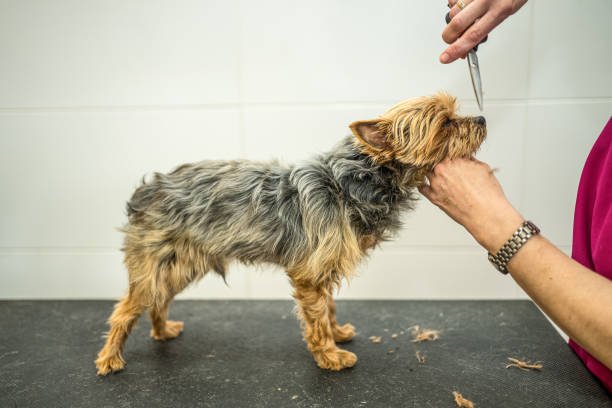
Coat Maintenance:
- Brushing: Regular brushing is essential to prevent matting and tangling of the Dandie Dinmont Terrier’s distinctive double coat. Aim for a few times a week to keep their coat healthy and free of debris.
- Trimming: While the breed standard doesn’t specify extensive trimming, occasional light trimming around the eyes and paws can help maintain cleanliness and prevent irritation.
Bathing:
Frequency: Dandie Dinmont Terriers don’t require frequent baths. Aim for a bath every 2-3 months or when they get visibly dirty. Over-bathing can strip their coat of natural oils, leading to dryness.
Ear Care:
Regular Checks: Due to their drop ears, Dandie Dinmont Terriers are prone to ear infections. Regularly check their ears for redness, odor, or signs of discomfort. Clean them gently with a veterinarian-recommended solution.
Dental Care:
Brushing: Establish a routine of brushing your Dandie Dinmont Terrier’s teeth to prevent dental issues. Use a dog-friendly toothbrush and toothpaste to maintain good oral hygiene.
Accessories and Care Products:
Taking care of your Dandie Dinmont Terrier involves using the right accessories and care products. Here are some recommendations:
Grooming Tools:
- Slicker Brush: Ideal for removing loose hair and preventing matting in the soft undercoat.
- Comb: Use a comb to detangle any knots and ensure a smooth coat.
- Nail Clippers: Keep their nails trimmed to a comfortable length, avoiding overgrowth.
Harnesses and Collars:
- Harness: Due to their unique body shape, a harness can be more comfortable than a collar, preventing strain on the neck during walks.
- ID Tag: Ensure your Dandie Dinmont Terrier wears an ID tag with updated contact information for identification purposes.
Toys:
- Interactive Toys: Keep them mentally stimulated with toys that challenge their intelligence.
- Chew Toys: Provide appropriate chew toys to satisfy their natural chewing instincts and promote dental health.
Remember, each Dandie Dinmont Terrier is unique, so adapt your grooming routine based on their specific needs and preferences. Regular grooming sessions also provide an opportunity to check for any skin issues, lumps, or abnormalities that may require veterinary attention.
Choosing and Adopting a Dandie Dinmont Terrier:
Reasons for Adoption:
Adopting a Dandie Dinmont Terrier comes with numerous benefits, not only for the prospective owner but also for the dog itself. Highlighting these advantages can encourage potential adopters to consider giving a rescue dog a second chance.
- Companionship: Dandie Dinmont Terriers are known for their loyalty and affectionate nature, offering companionship to individuals and families.
- Rescue and Second Chance: Adopting from a rescue gives dogs a second chance at a loving home. Many Dandie Dinmont Terriers in rescues are loving, well-behaved dogs looking for a permanent home.
- Emotional Fulfillment: Providing a home for a rescue dog can be emotionally fulfilling, knowing that you’ve made a positive impact on their life.
Research and Preparation:
Before adopting a Dandie Dinmont Terrier, it’s crucial to conduct thorough research and make necessary preparations. This ensures a smooth transition for both the dog and the adoptive family.
- Breed-Specific Needs: Understand the specific needs of Dandie Dinmont Terriers, including their exercise requirements, grooming needs, and any health considerations.
- Financial Responsibilities: Owning a dog comes with financial responsibilities. Ensure you can afford veterinary care, grooming, and general maintenance costs.
Adoption Process:
Adopting a Dandie Dinmont Terrier typically involves a series of steps through reputable rescues or breed-specific organizations. Outlining the adoption process helps potential adopters know what to expect.
- Research Rescues: Identify reputable rescues or organizations that specialize in Dandie Dinmont Terrier adoptions.
- Application: Complete an adoption application, providing details about your living situation, experience with dogs, and the type of environment you can offer.
- Home Visit: Some rescues conduct home visits to ensure it’s a safe and suitable environment for the dog.
- Meet and Greet: Once approved, arrange a meeting with the Dandie Dinmont Terrier you’re interested in. This allows you to assess compatibility.
- Adoption Fee: Be prepared for an adoption fee, which often covers vaccinations, spaying/neutering, and other medical expenses.
- Paperwork: Complete any necessary paperwork and obtain information about the dog’s medical history.
Breeding and Ethical Considerations:
While adoption is a wonderful option, some individuals may choose to purchase a Dandie Dinmont Terrier from a breeder. In such cases, it’s crucial to prioritize responsible breeding practices.
- Research Breeders: Look for reputable breeders with a commitment to the health and well-being of the dogs. Seek recommendations and reviews.
- Health Screening: Ethical breeders conduct health screenings to ensure their breeding dogs are free from genetic disorders.
- Genetic Diversity: Responsible breeding involves maintaining genetic diversity within the breed to prevent the proliferation of hereditary issues.
By understanding the adoption process and considering ethical breeding practices, prospective Dandie Dinmont Terrier owners can make informed decisions that prioritize the well-being of the dogs.
Conclusion:
In conclusion, the Dandie Dinmont Terrier is a unique and charming breed with a rich history and distinctive traits. From their playful demeanor to their loyal nature, these terriers make wonderful companions for the right family. Responsible ownership, including proper grooming, training, and veterinary care, is key to ensuring the well-being of these delightful dogs.
As you consider adding a Dandie Dinmont Terrier to your family, remember the importance of adoption. Many Dandie Dinmont Terriers are looking for loving homes in shelters and rescue organizations. By adopting, you not only provide a home for a dog in need but also contribute to responsible pet ownership.
Explore resources from breed clubs, reputable breeders, and rescue organizations to gather more information about the Dandie Dinmont Terrier and make an informed decision that aligns with your lifestyle.
Whether you’re drawn to their unique appearance, playful antics, or unwavering loyalty, the Dandie Dinmont Terrier is truly a breed worth considering for those seeking a special canine companion.
FAQs
What is the origin of the name “Dandie Dinmont Terrier”?
The breed is named after a character in Sir Walter Scott’s novel “Guy Mannering.” Dandie Dinmont is a farmer in the novel who owned terriers, and the name stuck with this distinctive terrier breed.
How do you groom a Dandie Dinmont Terrier?
Dandie Dinmont Terriers have a unique double coat that requires regular grooming. Brush their wiry topcoat to prevent matting, and hand-strip the coat a few times a year to maintain its texture. Regular ear cleaning, nail trimming, and dental care are also essential.
Are Dandie Dinmont Terriers good with children?
Yes, Dandie Dinmont Terriers are known for being safe and playful with children. They form strong bonds with their families and can be delightful companions for kids.
What are the exercise needs of Dandie Dinmont Terriers?
While specific details about their exercise needs are not known, Dandie Dinmont Terriers are generally active and enjoy playtime. Daily walks and interactive play sessions are recommended to keep them mentally and physically stimulated.
Do Dandie Dinmont Terriers get along with other pets?
Yes, with proper introduction and socialization, Dandie Dinmont Terriers can get along well with other pets. Their amiable nature makes them adaptable to living with other animals.
Are Dandie Dinmont Terriers good apartment dogs?
Yes, Dandie Dinmont Terriers can adapt to apartment living, but they still need regular exercise and playtime. Providing them with enough mental and physical stimulation is crucial for their well-being.
What health considerations should be taken for Dandie Dinmont Terriers?
While specific health details are not known, Dandie Dinmont Terriers, like all breeds, may be prone to certain health issues. Regular veterinary check-ups, a balanced diet, and preventive care are essential for their overall health.
Is the Dandie Dinmont Terrier a rare breed?
Yes, the Dandie Dinmont Terrier is considered a rare breed. While not among the most popular, they have a dedicated fan base attracted to their unique appearance and charming personality.
Can Dandie Dinmont Terriers be trained easily?
Yes, Dandie Dinmont Terriers are intelligent and respond well to positive reinforcement training. Consistency and early socialization are key to shaping their well-mannered behavior.
How can I find a reputable Dandie Dinmont Terrier breeder?
To find a reputable breeder, research breed clubs, attend dog shows, and seek recommendations. Responsible breeders prioritize the health and well-being of the dogs, conducting health screenings and maintaining ethical breeding practices.

















